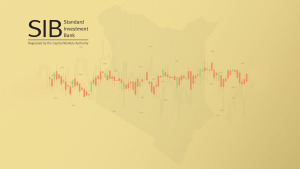A hard road to a soft landing
Well, that was a pleasant surprise. 2023 was a year that defied expectations by many accounts. A number of forecasts predicted that the US economy would enter a recession in 2023 as the Federal Reserve raised interest rates to fight high inflation. But the economy remained resilient, inflation eased, and the Fed declined to lift rates later in the year. US stocks rose in 2023, despite some setbacks along the way. Many economists who called for a recession have since walked back their predictions.
Despite widespread prognostications for a continuation of the 2022 bear market and a looming potential recession, The Nasdaq-100 had its best annual performance (53.8%) since 1999 while the broader-based S&P 500 had a more than respectable return of 24%. The blue-chip Dow Jones Industrials underperformed with a relatively modest return of 13.7%; however, both the Dow and Nasdaq 100 were the first of the major equity benchmarks to return to new all-time highs in December extending a bull-market rally that began in earnest in late 2022. Smaller cap stocks had been the worst performers until the last two months of the year, where over the final nine weeks of 2023, the Russell 2000 rebounded with a ferocious 24.3% rally as the index closed with an annual 15.09% gain.
Global stock markets also bounced back after posting their worst year since the financial crisis. Equities, as measured by the MSCI All Country World Index, rose 22.2% even as geopolitical tensions increased with war continuing in Ukraine and hostilities erupting in the Middle East. Developed international stocks, as represented by the MSCI World ex-USA Index, added 17.9%, while emerging markets notched smaller gains, with the MSCI Emerging Markets Index up only 9.8%. Even the bond market has perked up after a historic downturn, one that briefly sent yields to highs not seen since before the 2008-09 financial crisis.
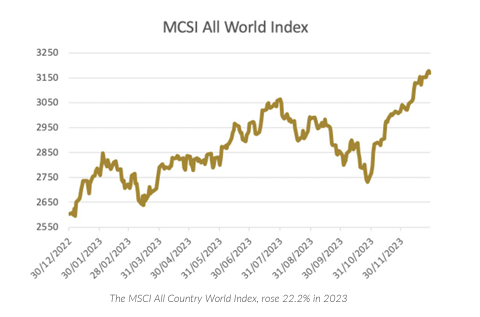
All bull markets have their own wall of worries to overcome, and the current times are no exception. After raising rates three times in the year’s first half, the Fed made only one additional increase in the second half of 2023 given US inflation continued to retreat from June 2022’s four-decade high of 9.1%, with the 12-month rise in consumer prices falling to 3.1% in November, a lower level than many had expected. Despite a prolonged and ongoing inversion of the yield curve and now 20 consecutive monthly declines in the Leading Economic Index, which is meant to provide insight on where we are in the business cycle, a recession never came to fruition and Q3 real GDP was up 4.9%. A bank crisis in March saw three of the four largest U.S. bank failures on record (after Washington Mutual in 2008) as the rapid rate increases in early 2023 left some regional lenders in precarious financial positions, with the value of their long-term Treasury bonds sinking.
Against this backdrop, politicians in Washington debated the US debt ceiling and government funding. The president and Congress eventually agreed to raise the debt limit in June, avoiding a US default. Despite the two-year spending deal, Fitch downgraded its credit rating on US debt, citing the country’s rising fiscal deficits and “the erosion of governance” that has led to multiple clashes over the debt limit in recent decades. However, stock and bond markets seemed to take all this news in stride. While geopolitical conflicts, debt ceiling debates and credit rating downgrades often dominate headlines, market reactions can be muted. The threat of a shutdown still looms if a longer-term funding resolution isn’t reached in early 2024, but, as far as stock returns are concerned, history shows that a US government shutdown isn’t necessarily a factor that causes poor equities performance.
Among the strongest performers in 2023 were technology stocks, recovering after a horror showing in 2022. Much of the stock market’s gains can be attributed to just a handful of companies, recently dubbed the “Magnificent Seven” namely Apple, Amazon, Alphabet, Meta Platforms, Microsoft, Nvidia and Tesla. Combined, they contributed approximately 70% of the total return in the S&P 500 index last year. They were led by NVIDIA amid strong sales of its computer chips, as interest in artificial intelligence built after the release of ChatGPT. However, valuations for those seven stocks remain high, with an aggregate price-to-book (P/B) ratio of 12.71. This helped push up the Nasdaq’s P/B ratio to 5.83. While high valuations may seem like a concern, there lies a possibility that Artificial Intelligence proliferation will turbo boost efficiency and spur earnings growth for these companies in the mid to long term future. These gains of the growth-oriented US tech sector helped growth stocks outperform value stocks on a global basis and in the US, despite a strong finish to the year for value.
Eurozone
The final quarter of the year was a strong one for European markets, boosted by expectations that there may be no further interest rate rises. The Euro Stoxx 50, which comprises blue chip companies from 11 European countries advanced 13.55% during the quarter. Shares were supported by softer inflation figures from both the eurozone and the US, which raised hopes that interest rates may not only have peaked, but that cuts could soon be on the way in 2024. Euro area annual inflation fell to 2.4% in November from 2.9% in October. A year previously, the annual inflation rate was 10.1%.
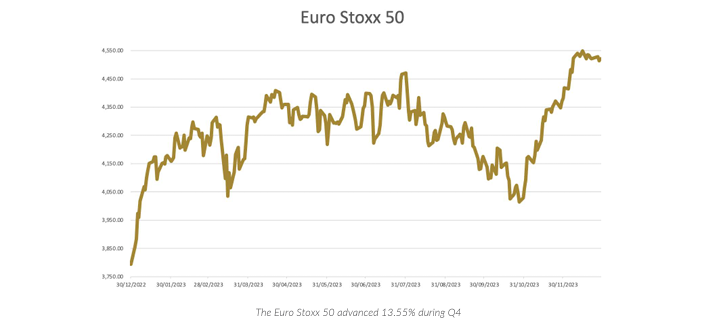
Higher interest rates have weighed on the eurozone economy. Eurozone GDP fell by 0.1% quarter-on-quarter in Q3, Eurostat data showed. The Hamburg Commercial Bank flash eurozone purchasing managers’ index (PMI) fell to 47.0 in December. This suggests that the region’s economy is likely to have contracted in Q4 as well. (The PMI indices are based on survey data from companies in the manufacturing and services sectors. A reading below 50 indicates contraction, while above 50 signals expansion.)
Most sectors rose amid optimism over future rate cuts leading to the small and mid-cap companies outperforming the broader market. The real estate sector advanced strongly amid the prospect of a cheaper cost of debt. IT stocks, the value of which is based on future cash flows and earnings, also performed well. Other economically sensitive sectors such as industrials and materials registered strong gains. By contrast, the energy sector fell amid weaker oil prices. Stock-specific factors weighed on the healthcare sector.
Asian Markets
Apart from the Chinese market, where shares fell due to investor concerns over weaker economic growth, Asian equity markets across the board gained during the fourth quarter. Hopes that US interest rates may have peaked led to renewed investor appetite for risk assets across the region. Taiwan, South Korea, and India were the strongest Asian markets in the quarter, with all three achieving robust growth. In Taiwan and South Korea, technology stocks and chipmakers gained as investor enthusiasm over artificial intelligence continued to accelerate. Malaysia, the Philippines, and Singapore also achieved strong growth in the fourth quarter, while gains in Japan were more muted. Despite the macroeconomic conditions in Japan continuing to improve, equity markets lagged as investors became concerned about yen appreciation as the TOPIX index only gained 2% during the quarter.
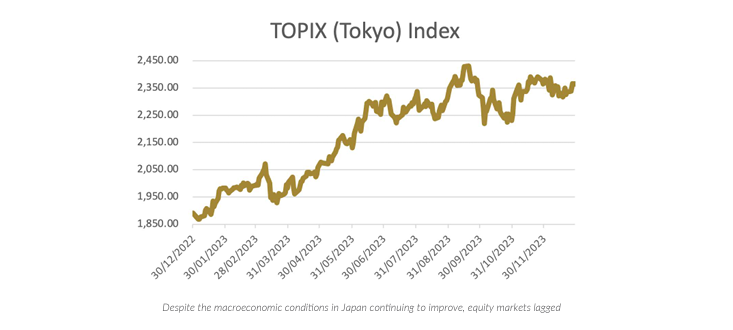
Meanwhile, 2023 was a disappointing year for Chinese equities. Economists and analysts see little sign that Beijing is willing to take the more aggressive steps needed to stabilize the property market—which accounts for a quarter of its economic activity—and restore economic confidence more broadly after a period of erratic policy measures. Confidence in the economic recovery among households, businesses, and investors has been deteriorating, as reflected in Hong Kong’s stock market with the Hang Seng Index loosing almost 14% throughout the year.
Bargain-hunters who were hoping Beijing had learned from past missteps—such as its harsh Covid-19 restrictions and crackdowns on its tech sector—were disappointed in late December when a regulatory agency proposed restrictions on online gaming. The draft regulation sent Chinese stocks careening and blew apart the notion that the government crackdown on the internet sector was near an end. The draft reinforced the continued risk of arbitrary policy measures and increased intervention in the private sector that have sent investors fleeing away. Indeed, Xi Jinping prepped the country for more challenges ahead in his year-end speech, noting: “On the path ahead, winds and rains are the norm.”
Fixed Income
Fixed income markets marked their best quarterly performance in over two decades, according to the Bloomberg Global Aggregate Bond index which shot up 5.4% over the last 3 months of the year. The major driver of this performance was a perceived shift in monetary policy direction, from a “higher-for-longer” stance to prospective rate cuts. Government bond yields fell sharply, and credit markets rallied, outperforming government bonds.
The US Federal Reserve (Fed) kept rates unchanged throughout the quarter, with a much clearer shift to a more dovish tone in December accelerating the market rally. The revised dot plot – a chart plotting Federal Open Market Committee (FOMC) projections for the federal funds rate – indicated that three rate cuts are now anticipated for 2024, up from the previously expected two. With more encouraging news on CPI figures, the Fed appears more comfortable with the progress made in bringing inflation back towards its 2% target.
Other major central banks held steady rates, although they appeared more cautious about inflation. The European Central Bank (ECB) made progress in its plan to unwind some of its Pandemic Emergency Purchase Programme support, while highlighting concerns about domestic inflation. However, the market is still pricing in several rate cuts in 2024. Meanwhile, the Bank of England’s Monetary Policy Committee remained divided on further tightening. The latest inflation release surprised to the downside which extended the gilt market rally. Elsewhere, the Bank of Japan’s decision to make only minor adjustments to its yield curve control policy fell short of market expectations. As markets priced in easing conditions, government bond yields fell across the board.
The US 10-year Treasury yield fell from 4.57% at the end of Q3 to 3.87% at the end of Q4. The UK 10-year gilt yield fell from 4.44% to 3.54%, while the German 10-year Bund yield ended the quarter 0.81% lower at 2.03%.
Despite a slowing growth outlook, the corporate bond market staged an impressive rally on hopes that a deep recession could be averted as financial conditions eased. High yield markets outperformed investment grade in both the US and Europe, with a tightening of spreads also marking significant outperformance over government bonds. Investment grade bonds are the highest quality bonds as determined by a credit rating agency; high yield bonds are more speculative, with a credit rating below investment grade.
Meanwhile, quarterly returns in US and European investment grade credit markets have not been better since Q3 2009. The rally was broad-based across all sectors, with securitised credit, covered bonds, and quasi-government bonds all performing strongly over the quarter.
Commodities
The S&P GSCI Index declined 12.14% in the fourth quarter, with price gains for precious metals and industrial metals failing to offset weaker prices for agriculture, energy, and livestock commodities. Energy was the worst performing component during the quarter, with sharply lower prices for natural gas (-16.54%), WTI crude oil (-21.40%) & Brent Crude Oil (-16.32%). Oil prices fell despite output cuts from Opec+ (the Organization of the Petroleum Exporting Countries, plus some other oil-producing countries) as disappointing economic data from China indicated that near term demand from the second largest economy might be lower thus weighing down on prices. Gold was the number one performing metal last year and only one of two that finished the year in the green, copper (+2.01%) being the other. The precious metal rose 11.58% during the quarter to close the year above $2,000 per ounce for the very first time, and it has now advanced in 16 of the past 23 years, since the turn of the century. In industrial metals, nickel and lead prices fell during the quarter, while zinc, copper, and aluminium achieved gains.
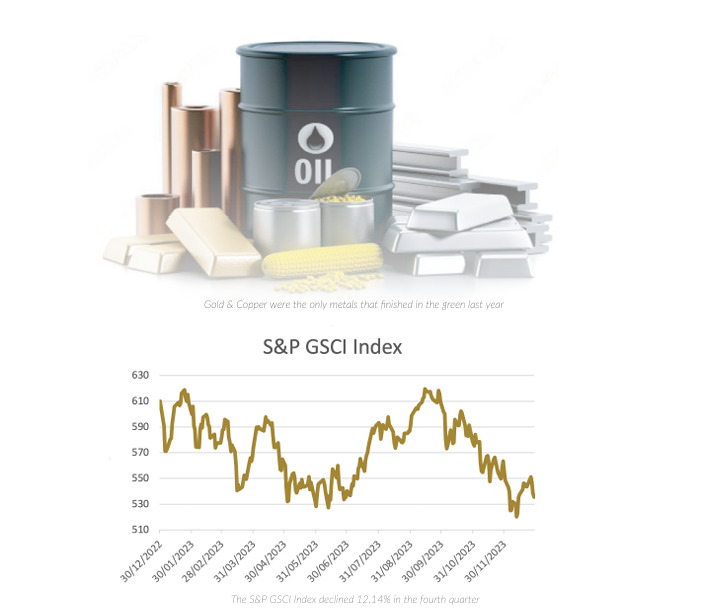
Nairobi Securities Exchange
The equities market receded 3.3% in the fourth quarter of 2023 with October printing a 7.0%m/m fall that was diluted by the gains in November (+3.8%m/m) and December (+0.2%m/m). In the year, all the benchmark indices posted double-digit losses with the NSE All-Share Index (NASI) leading the losing charge on a 27.7%y/y decline. The NSE 20 and the NSE 25 dropped by 10.4%y/y and 24.0%y/y respectively. This was the second year of continued losses. In 2022, the NASI, NSE 20, and the NSE 25 shed 23.4%y/y, 11.9%y/y, and 16.3%y/y respectively.
The Nairobi Securities Exchange launched a new index, dubbed the N10, that’s market cap determined and float-adjusted. The base date for the N10 was on 30th August 2023 at 1,000 points. From launch, the N10 shed 9.2% by the close of the year. From our peer universe of 17 African stock markets, the NSE was the worst-performing African market with a negative dollar return of 42.4%. Broadly, 8 markets posted negative dollar returns while 9 printed positive dollar returns – reflecting a mixed performance in the region.
Turnover for the quarter stood at USD 71.5m down from USD 114.7m in the third quarter. In the year, the value of shares traded was USD 558.1m, lower than USD 753.5m in 2022. We note that turnover has been on a downward trend since 2019. The subdued trading activity was a result of several factors, both global and local. Firstly, the rising interest rates globally resulted in capital flights from frontier markets – as investors with exposure to developed markets and top-tier emerging markets skewed their portfolios toward higher liquidity holdings, defensive stocks, and bond holdings in their home markets. Secondly, the rising local rates saw a further rise in investor apathy toward equities and increased holdings in short-term bills and bonds.
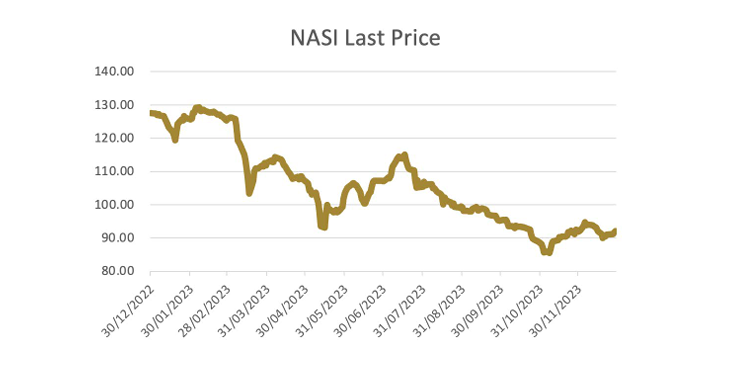
Looking ahead to 2024
The year ahead looks to be a geopolitical minefield, led by the conflicts between Russia-Ukraine and Israel-Hamas. Developments in the middle east in particular could disrupt the progress being made on the fight against Inflation with observers having described the current f ighting in Gaza as just the first phase of a conflict that they see expanding through the course of the year. The largest global shipping companies have already suspended transit through the Red Sea amid Houthi strikes, freezing a waterway through which 12% of global trade passes. This has led to freight insurance rates spiking over the last month while the need for ships to use longer routes has increased the turnaround time by 14 days. If these attacks persist, the global economy should brace for global supply disruptions and the closer the conflict comes to Iran, the more likely oil flows could be disrupted, pushing crude oil prices higher, which could snowball into rising consumer prices.
Four years after the outbreak of the global pandemic, the global economy remains somewhat fragile and uncertain. The pandemic exposed and exacerbated the structural weaknesses and vulnerabilities of an interconnected global economy, one which is beginning to splinter into rival blocs. While potentially in only its early stages, the off shoring, re-shoring, and all-around realignment of global trade between these blocs is going to have a major impact on the world. Supply chains will be reshaped, relationships between companies will have to adapt, and new competitions will undoubtably start to emerge. In 2024, we shall start to see how this reshaping could take place as more than 50 countries and regional bodies are experiencing major elections during year, with the United States election in November taking centre stage. The impact of these elections on geopolitics and global business will be enormous, potentially shaping the policies and priorities of some of the world’s largest and most influential economies. Alliances, trade agreements, and joint ventures are all dependent on this.
A core challenge facing the global economy going into 2024 continues to be, of course, inflation. In 2024, the inflation rate likely will fluctuate across countries and regions, depending on their economic conditions, policy responses, and external shocks. According to the Internat ional Monetary Fund (IMF), the global inflation rate is projected to be 5.8% in 2024 not expected to return to target levels of around 2% until 2025. However, this global average masks significant differences among countries and regions. For instance, advanced economies are expected to see inflation of less than 3.0% in 2024, after averaging 4.6% in 2023. Emerging market and developing economies, however, are expected to see 7.8% inflation on-top of the 8.5% inflation they saw in 2023, a significant struggle for nations that were already harder hit by the pandemic. The inflation dynamic in 2024 will have important implications for the global economy, as it will affect exchange rates, interest rates, asset prices, income distribution, and the debt sustainability of many countries and regions. It will also pose challenges and opportunities for businesses and professionals, which will have to adapt to the changing price levels and expectations while managing the associated risks and uncertainties.
Add to this worrisome economic picture the slowdown in China, the world’s second-largest economy and the largest trading partner of many countries and regions. China has been the main engine of global growth for the past four decades; however, its growth model — which relies heavily on investment, exports, and debt — may have reached its limits. Now, the country is facing multiple headwinds, such as an aging population, high unemployment among younger workers, declining productivity, and a significant real estate crisis. China’s slowdown will have a cascading effecting into foreign policy and other key interest areas, the full extent of which will depend on the responses of its government to the challenge.
Despite all this, market performance in 2023 marked a clear departure from 2022, with several asset classes performing both better than they did in 2022 and above consensus expectations. We head into 2024 more optimistic on the resilience of global economies than we were entering 2023, as cooling inflation and the end of monetary tightening will hopefully return us to an investing environment similar to that between the Global Financial Crisis and Covid-19. While the S&P 500 isn’t cheap at 19 times 2024’s expected earnings, and the timing and pace of rate cuts are uncertain, stocks look poised for another strong year as last year’s narrow rally started showing signs of broadening out to encompass the larger market towards the final months of the year.
Earnings, for one, will return as a positive driver for stocks in 2024. Based on consensus estimates, Wall Street analysts expect a 12% rise in S&P 500 earnings during the year which is a stark contrast to the meagre 2% growth in earnings that was seen in 2023. Lower interest rates nonetheless will grease stocks’ path higher, lowering the cost of doing business and boosting liquidity and earnings. How low remains the subject of heated discussion, however as the fed seems to be contemplating three rate cuts of a 0.25 percentage point each in 2024, based on median estimates in the Fed’s latest “dot plot” of interest rate projections. However, investors are betting on more cuts than that. Futures-market pricing suggests that the Fed will start lowering rates in March, according to the CME FedWatch Tool. The market is pricing in a total of 1.50 percentage points of cuts by year end. This could happen for two reasons: if the fed needs to bolster a flagging economy or to keep its policy stance from growing more restrictive as inflation continues to fall and reaches the 2% target faster than expected.
AI was certainly the buzzword of the year in 2023. Its potential to boost productivity is significant and we are also firm believers in its long-term power. AI will affect just about every industry from manufacturing to services businesses to healthcare. Similar to the early days of the internet, the greatest use cases of AI might not even be known yet. In the long run, AI is a game changer, but the near-term pricing on several AI stocks is reminiscent of the tech bubble of 1999. While anything is possible, it is still early days and as such there is still potent ial for further gains.
Over the last two years, central banks were trying to achieve the economic holy grail, by raising interest rates to rein in inflation without causing a recession. The aim was a soft landing, but the glide path was bumpy and so far, it seems like the economic nirvana might actually be achieved as inflation has come down faster than expected while unemployment rate is still hovering at record lows.
In the complex tapestry of global events, the art of forecasting is dicey at best, yet the value lies in offering a path to preparedness. And while 2024 is likely to be as full of surprises as each of the years so far in this decade, there still some lingering major geopolitical and economic challenges that the world will face, the likes of which demand preparation and forethought from the ongoing wars in Ukraine and the Middle East to questions around interest rates. Investors are also likely to be closely following the upcoming presidential election in the US and how that will affect US economic and foreign policy stances. How do you price chaos? Do you buy it, sell it, or wait for something truly shocking to happen? Those are perhaps the most critical investment questions as geopolitical tensions continue to illuminate the world’s disequilibrium. That’s why we continue recommending that investors plan for a long-term horizon as markets provide more evidence that time in the market will always outperform timing the markets.
Disclosure and Disclaimer
Analyst Certification Disclosure: The research analyst or analysts responsible for the content of this research report certify that: (1) the views expressed and attributed to the research analyst or analysts in the research report accurately reflect their personal opinion(s) about the subject securities and issuers and/or other subject matter as appropriate; and, (2) no part of his or her compensation was, is or will be directly or indirectly related to the specific recommendations or views contained in this research report.
Global Disclaimer: Standard Investment Bank (SIB) and/or its affiliates makes no representation or warranty of any kind, express, implied or statutory regarding this document or any information contained or referred to in the document. The information in this document is provided for informational purposes only. It does not constitute any offer, recommendation or solicitation to any person to enter into any transaction or adopt any hedging, trading or investment strategy, nor does it constitute any prediction of likely future movements in rates or prices, or represent that any such future movements will not exceed those shown in any illustration. The stated price of the securities mentioned herein, if any, is as of the date indicated and is not any representation that any transaction can be effected at this price. While reasonable care has been taken in preparing this document, no responsibility or liability is accepted for errors of fact or for any opinion expressed herein. The contents of this document may not be suitable for all investors, as it has not been prepared with regard to the specific investment objectives or financial situation of any particular person. Any investments discussed may not be suitable for all investors. Users of this document should seek professional advice regarding the appropriateness of investing in any securities, financial instruments, or investment strategies referred to in this document and should understand that statements regarding future prospects may not be realised. Opinions, forecasts, assumptions, estimates, derived valuations, projections, and price target(s), if any, contained in this document are as of the date indicated and are subject to change at any time without prior notice. Our recommendations are under constant review. The value and income of any of the securities or financial instruments mentioned in this document can fall as well as rise, and an investor may get back less than invested. Future returns are not guaranteed, and a loss of original capital may be incurred. Foreign-currency denominated securities and financial instruments are subject to fluctuations in exchange rates that could have a positive or adverse effect on the value, price, or income of such securities and financial instruments. Past performance is not indicative of comparable future results, and no representation or warranty is made regarding future performance. While we endeavour to update on a reasonable basis the information and opinions contained herein, there may be regulatory, compliance, or other reasons that prevent us from doing so. Accordingly, information may be available to us which is not reflected in this material, and we may have acted upon or used the information prior to or immediately following its publication. SIB is not a legal or tax adviser and is not purporting to provide legal or tax advice. Independent legal and/or tax advice should be sought for any queries relating to the legal or tax implications of any investment. SIB and/or its affiliates may have a position in any of the securities, instruments, or currencies mentioned in this document. SIB has in place policies and procedures and physical information walls between its Research Department and differing business functions to help ensure confidential information, including ‘inside’ information, is not disclosed unless in line with its policies and procedures and the rules of its regulators. Data, opinions, and other information appearing herein may have been obtained from public sources. SIB makes no representation or warranty as to the accuracy or completeness of such information obtained from public sources. You are advised to make your own independent judgment (with the advice of your professional advisers as necessary) with respect to any matter contained herein and not rely on this document as the basis for making any trading, hedging, or investment decision. SIB accepts no liability and will not be liable for any loss or damage arising directly or indirectly (including special, incidental, consequential, punitive, or exemplary damages) from the use of this document, howsoever arising, and including any loss, damage, or expense arising from, but not limited to, any defect, error, imperfection, fault, mistake, or inaccuracy with this document, its contents, or associated services, or due to any unavailability of the document or any part thereof or any contents or associated services. This material is for the use of intended recipients only, and in any jurisdiction in which distribution to private/retail customers would require registration or licensing of the distributor, which the distributor does not currently have, this document is intended solely for distribution to professional and institutional investors.



